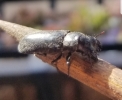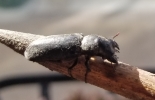
Invertebrates
See our handy guide to critters found in local homes and our Central Coast Butterfly FAQ. Browse the insects and other terrestrial arthropods we’ve identified. Check out local marine invertebrates, particularly bivalve mollusks and intertidal organisms.
- Anthropology
- Rocks & Fossils
- Invertebrates
- Vertebrates
- Botany
- Astronomy
- Fungi
- General
- Recently Asked
What kind of beetle is this?
We found this black beetle with pincer-looking horns on our second story balcony, hanging out in the afternoon sun on the stucco. It was probably about 0.75 inches in length. Can you tell what it is?


Curator Response
Dear Scott,
This magnificent beetle is Polycaon stoutii, sometimes called the Black Polycaon (pronounced "polly-KAY-un"). It is in the family Bostrichidae, which includes many different species of beetles (35 in California), most of which bore into solid wood. Some can even be major pests of structural timbers and other wood products. Fortunately, although abundant in our area and attracted to many hardwood tree species, Polycaon stoutii is rarely a serious pest. The large, black adults do appear frequently on the outsides (and sometimes the insides!) of buildings even in urban areas in our region.
Perhaps the most amazing thing about this beetle is its longevity as a larva (grub): it can take up to 20 years to develop! Occasionally these beetles will emerge from cabinetry, hardwood flooring, or furniture in homes unexpectedly, usually having started developing in the felled wood at an early stage, before manufacture, and there is no known evidence that they re-infest finished wood. Those large "pincer-looking horns" are actually the mandibles (jaws), which the beetles use to start holes in wood in which the females lay eggs. The grubs that hatch out are white, squishy, and C-shaped, appearing similar to May or June beetle grubs that can be common in lawns; Polycaon grubs, though, are rarely seen since they stay inside the piece of wood until it's time to pupate and emerge.
Thanks for sharing!
Schlinger Foundation Chair and Curator of Entomology Matthew L. Gimmel, Ph.D.


